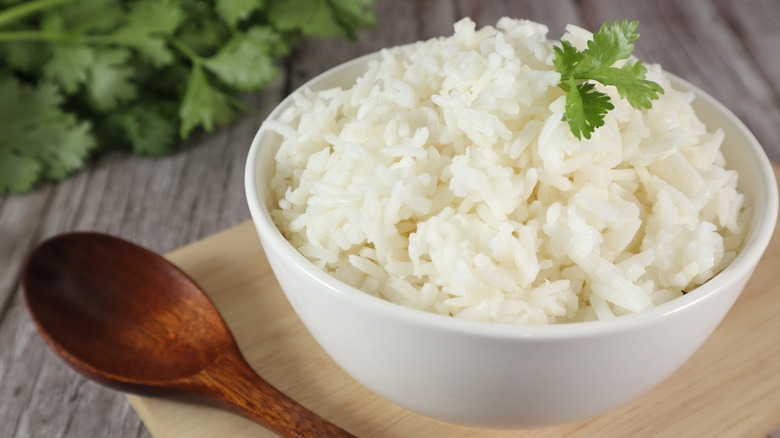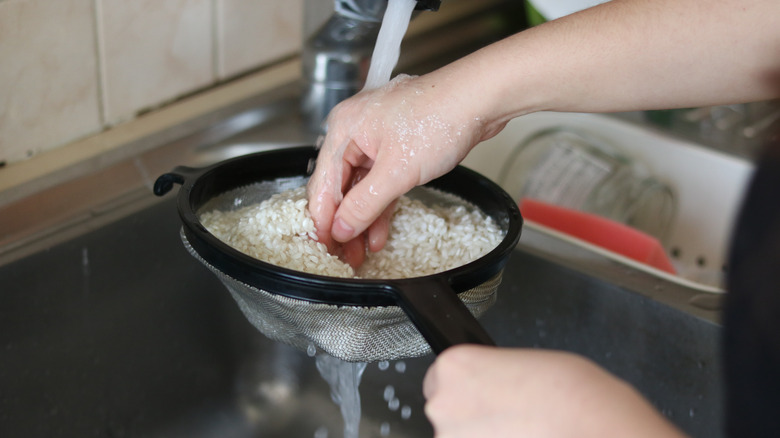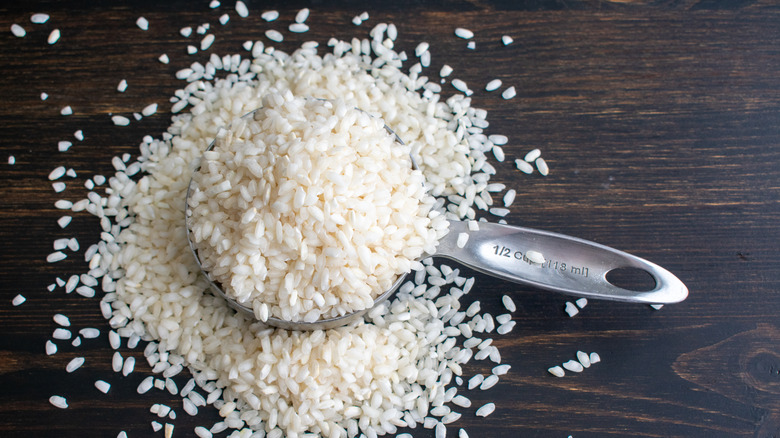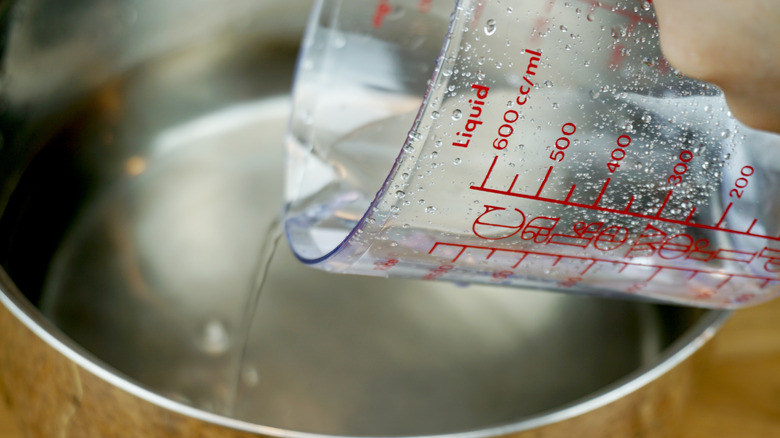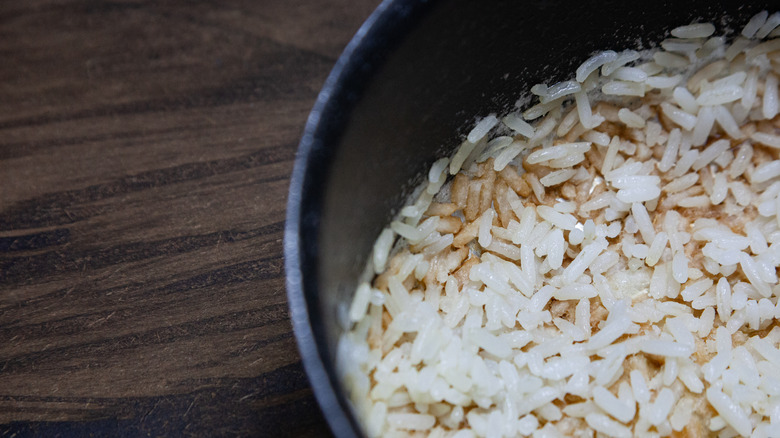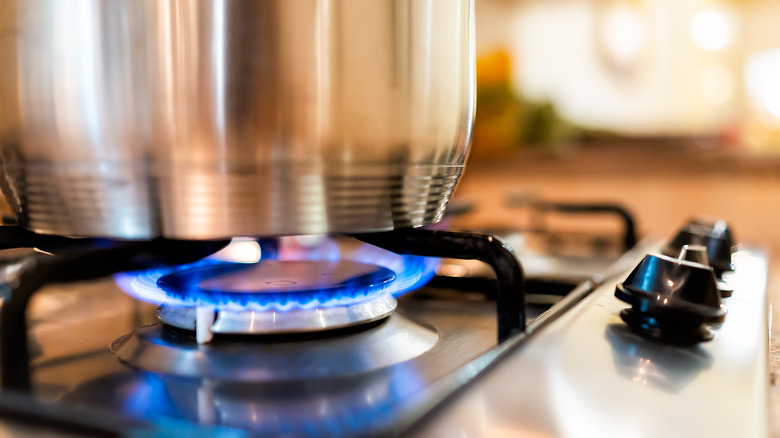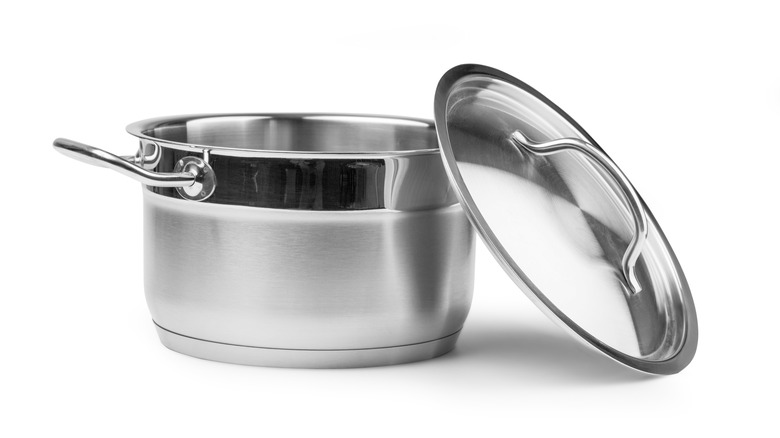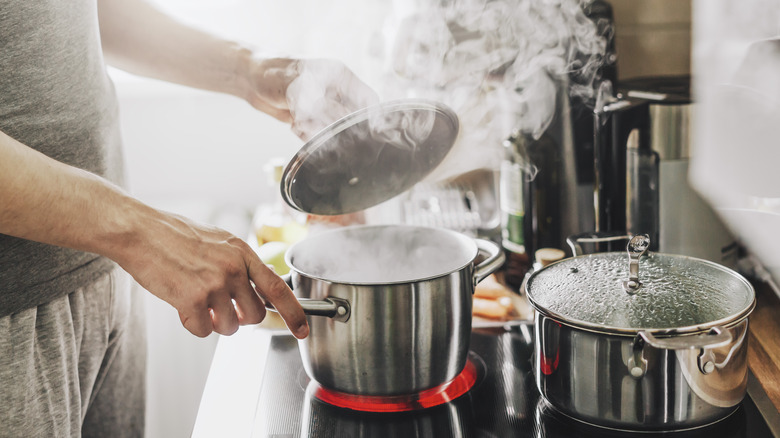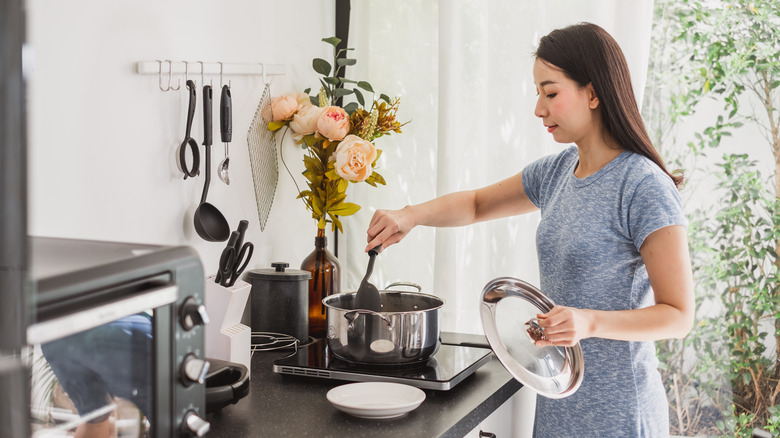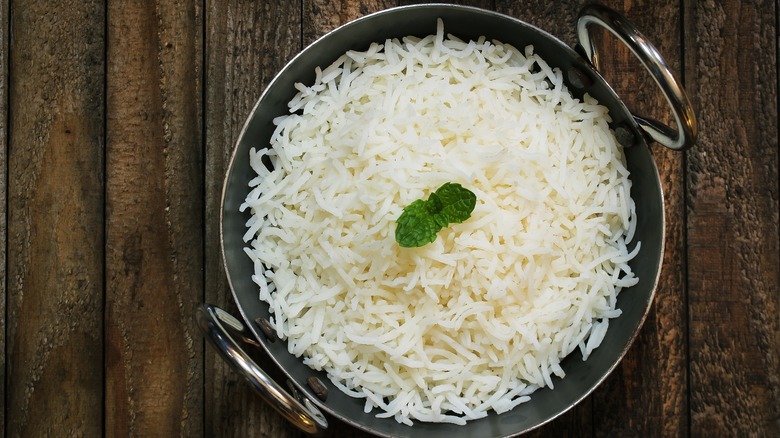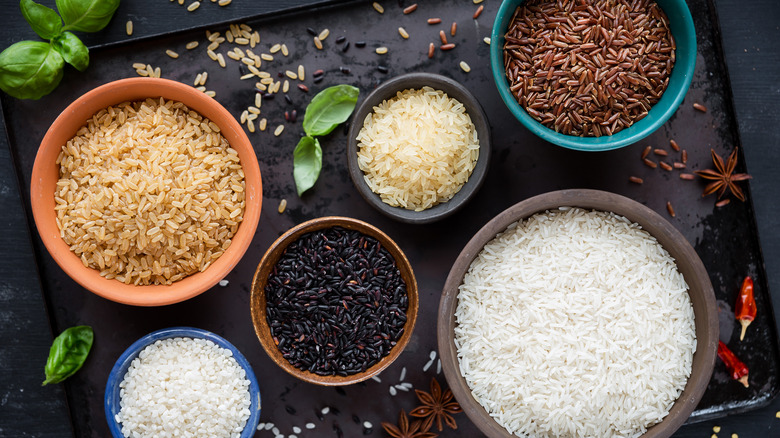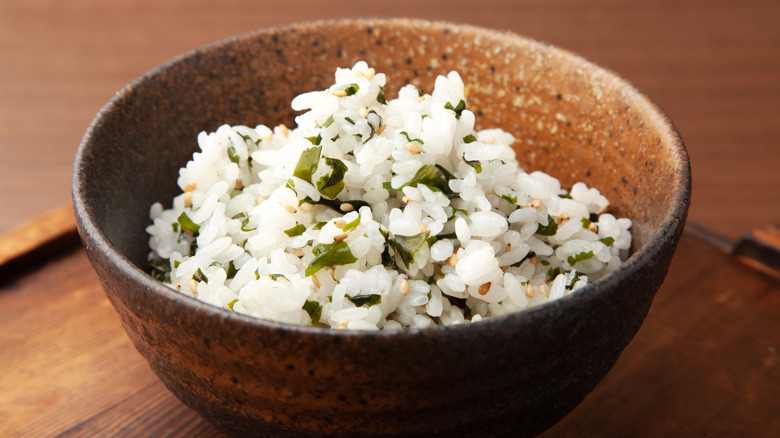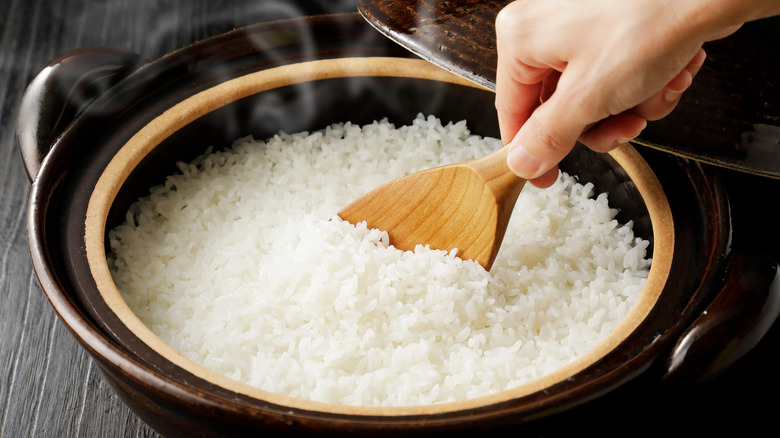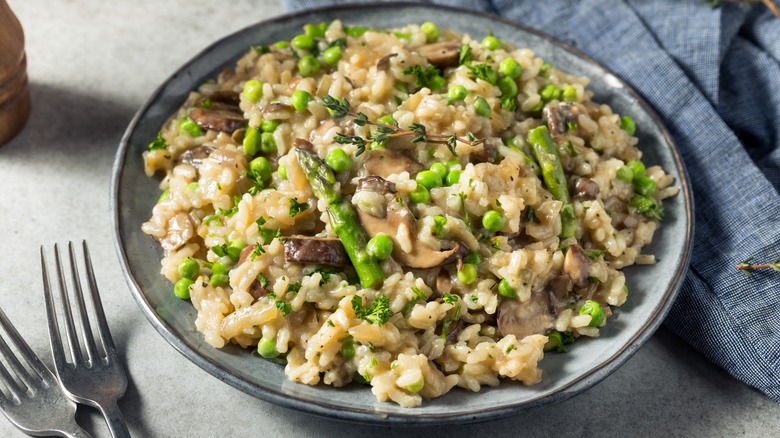Mistakes Everyone Makes With Rice
Although rice may seem pretty easy to prepare, the reality is that everyone makes mistakes. And these mistakes can be costly, affecting both texture and flavor, leading to mushy, bland, dry, or even burnt rice. Keep in mind that there are many different types of rice, which may require different measurements, cooking times, and preparation methods. Arborio rice, for example, is a short to medium-grain rice that can absorb flavorful liquids and is often used to make creamy risotto (per Consumer Reports). There are also many rice cooking methods, such as stove top, rice cooker, instant pot, or microwave. CNET ranks these four methods, concluding that high-end rice cookers, such as the Zojirushi Neuro Fuzzy, consistently produce the fluffiest rice. However, stick with stovetop cooking if you prefer a more flexible cooking method.
Beyond following package instructions, many rice enthusiasts offer additional tips to create the perfect pot of rice. Below, we discuss some of these tips and cover common mistakes everyone makes with rice.
Not washing the rice
Although this step isn't always listed on package instructions, you may wish to wash your rice before cooking it. The Food Network explains that when rice is left unwashed, excess starch can lead to "unappealing, gummy results." Another reason to rinse rice is to remove "dirt, dust, debris, chemicals, and bugs" (via Martha Stewart). While this may sound gross, remember that the rice you buy at your local market has probably come from far away, affecting its cleanliness. On top of that, it may still contain undesirable substances from the manufacturing process.
MasterClass explains two potential methods for washing rice. The first (and probably the easiest) is to use a fine-mesh strainer. Fill the strainer with rice, then run cold water over it until the water appears close to clear. Place a large bowl or pot underneath the strainer to assess water clarity, emptying the cloudy water as needed. The second method is to completely submerge your rice in a large bowl or pot under cold water. Then, swirl the rice around with your hand, held in a claw shape. Pour out starchy water until it appears almost clear (at least three times). Finally, drain the rice through a fine-mesh strainer.
Not salting the water
Although there is some debate over the importance of salting rice, many culinary experts in the US recommend adding salt to rice water to prevent blandness. Food52, on the other hand, proposes that adding salt to rice water may be unnecessary. The culinary site examines comments from a number of Redditors in the r/Cooking forum (via Reddit). Some cited Asian heritage as a point of authority since many Asian countries are well known for high rice consumption. During the 2021/2022 crop year, for example, China boasted the highest rice consumption in the world, consuming around 155 million metric tons of rice (per Statista) out of approximately 510 million metric tons worldwide (per Statista).
A Redditor named realmacarooni stated, "Speaking as a Chinese person who's seen both my grandmas, aunts, uncles, mom, dad, my Japanese gf's aunt, mom, dad, grandma and my Korean friends' families make rice, I've never seen them add salt. But if it tastes good to you, do what you do, that's the only thing that matters anyway." Still not sure whether to add salt or not? Go ahead and try it both ways to determine your personal preference.
Not measuring your rice accurately
Measuring out the wrong amount of rice is a common mistake everyone makes with rice –– and even a small amount of inaccuracy can make a big difference. To avoid this issue, use a dry measuring cup to scoop your rice out of its bag or canister. Then, use a scraper (or knife) to level off the top (per Oxo). Make sure to use dry measuring cups instead of liquid measuring cups for rice, though it may be easier to use the latter when measuring out the water.
Not everyone agrees that using a measuring cup (of any type) is necessary. Allrecipes presents a "Filipino trick" for measuring rice and rice water without a measuring cup. They suggest placing the desired amount of dry rice in a pot, rinsing it, and adding enough water to cover the rice barely. Then, put your fingers straight down into the pot until they touch the top of the rice, adding "more water until it reaches the first joint of your middle finger."
There's just one more important thing to keep in mind: If you have a rice cooker, you may have received a rice cup with it. While standard measuring cups contain 240 milliliters, most rice cups contain only 180 milliliters (via Greedy Panda).
Adding too much water
If you add too much water to your rice, it can turn out mushy and wet. And let's face it, nobody wants to eat that mess. Along with understanding the importance of accurate measurements, you should be aware that different rice varieties (short, medium, and long-grain) may require different amounts of water for the best results. For fluffy grains, use twice as much water as rice as a general guideline. Also, keep in mind that white rice tends to cook the fastest, while brown rice and other rice varieties usually take longer (per Allrecipes). Check package instructions for estimated cooking times.
You may be wondering what to do if your rice ends up being too wet. Fortunately, according to Fine Cooking, there are a couple of easy solutions. One is to take the cover off your pot and continue cooking over low heat on the stove until excess water has evaporated. Alternatively, spread the wet rice onto a baking sheet, then place it into the oven on low until it reaches the desired consistency.
Not adding enough water
According to Sprout Monk, when not enough water is added, rice can end up dry, crunchy, and undercooked. The solution is to add more water to the pot, replace the lid, and cook until the water has been absorbed. However, this may take some experimentation to get right. If the rice is only slightly dry, drizzle in some water. In more extreme cases of crunchy rice, consider cooking the rice again in a separate pot of boiling water. If your rice is burnt, it may be best to start over with new rice completely. Finally, a great tip to avoid dry, overly crunchy fried rice is to stir constantly while cooking (per Mashed).
It may be worth noting that some rice dishes are meant to be eaten crispy. If you're tired of soft, basic rice, you may enjoy Southern Living's Crispy Rice. This recipe requires a cast iron skillet, plenty of butter, a touch of sour cream, and some canola oil. Or, try making coconut rice with guandú (green pigeon peas), a classic Panamanian staple that offers a "golden crust" of rice (via Malena Nutricion).
Cooking at the wrong temperature
Cooking rice with the heat too low or too high can lead to undesirable results. Simply Recipes recommends starting your rice at medium-high heat before reducing it to simmer over medium-low. However, be aware that having the heat on too low will result in wet rice, requiring extra cooking time. On the other hand, if the heat is too high, your rice grains may be unevenly cooked or even burned. Plus, there's the risk of water boiling over onto your stovetop.
One easy way of ensuring that rice cooks at the right temperature is to use a rice cooker. As one rice enthusiast explains (via Huffington Post), "The magic of a rice cooker is that you push just one button (though fancier ones may have several buttons), and in 20 to 60 minutes you have perfectly fluffy white or brown rice."
There is no need to wait for the water to boil or add rice later in the cooking process with a rice cooker. You also don't need to constantly check on water levels, listen for the timer, or worry about whether the heat is too high or too low. Plus, a rice cooker can keep your rice warm, allowing rice preparation to occur hours before a meal. Some models even offer a delayed start. As a bonus, rice cookers can also be used to prepare other types of food, such as porridge.
Using the wrong pot
When it comes to making perfectly cooked rice, using the right pot matters. While a rice cooker is undoubtedly a good option, Elite Daily explains that it isn't the only one. If you decide to cook rice on your stovetop, choose a pot with "a tight fitting lid to hold in steam, a flat bottom, and at least a 1-quart capacity". Examples include the Dansk Teal Kobenstyle 2 Qt. Casserole and Le Creuset's Enameled Cast Iron Rice Pot with Lid & Stoneware Insert. For a more budget-friendly option, you can use a stainless steel pot with a glass lid. Even better, look for one with measurement markings inside.
As for rice cookers, there are many options on the market. Some offer only basic settings (i.e., "cook" and "keep warm"), while others boast a range of fancy features like special settings for different types of rice or pressure cooking (per New York Magazine's The Strategist). When choosing a rice cooker, you'll want to consider your desired settings and capacity. For instance, a three-cup rice cooker is suitable for about two people, whereas a five-cup rice cooker will feed a group of four. Model recommendations include the high-end Zojirushi NS-TSC10 and the more budget-friendly Aroma Housewares ARC-914SBD.
Opening the lid while cooking
While this action may be sorely tempting, it is important not to open the lid while your rice is still cooking. Two things happen when you open the lid: Steam escapes, and the cooking temperature is lowered (per the Insider). According to Mashed, these occurrences can mess with your meticulously measured rice-to-water ratio, resulting in dry, crunchy, or undercooked rice.
Dickson conducted an informal experiment to measure temperature change by lifting the lid of a rice pot. They found that soon after the lid was removed, the temperature inside of the pot dropped about 96 degrees Fahrenheit. Once the lid was replaced, the temperature rose back to its previous level about 30 seconds later. But this experiment only looks at half of the problem since humidity measurements to check for steam release have yet to be conducted. Even so, researchers concluded that leaving the pot on the rice resulted in better tasting rice with a more evenly cooked consistency.
If you plan to add seasoning while cooking, try adding it before covering the pot. And if you want to be able to check water levels along the way, consider selecting a pot with a glass cover.
Stirring while cooking
We have three little words for you on stirring the rice while cooking: Don't do it. Co-owner and Executive Chef Brian Enyart of Dos Urban Cantina in Chicago explains, "Stirring will help break down the rice and knock off the exterior starch a bit. When steaming rice, this will create a layer of starch in the bottom of your pan causing sticking and burning." Beyond that, Insider states that because stirring rice during cooking breaks up the grains, it can result in wet, mushy, unappealing rice.
There are some notable exceptions when it is okay to stir the rice during cooking, such as making risotto. This traditional Italian rice dish is made from arborio rice, stock, and butter (per Southern Living). To prepare, you slowly spoon simmering stock into your rice, waiting for it to absorb between additions. Risotto preparation requires quite a lot of stovetop attention since, in addition to slowly adding stock, you need to stir the rice every 30 seconds or so. But trust us, creamy risotto is well worth the trouble.
Not fluffing before serving
If you have not been fluffing your rice before serving it, it may be time to make some changes. The first thing to do, as Insider reminds us, is to leave your rice alone while it is still cooking. Once cooked, uncover the rice and let it rest for 10 minutes (per wikiHow). Next, gently stir with a carving fork for one minute; stirring for longer may lead to mushy rice. Finally, serve rice and enjoy.
CookThink explains why using a fork while fluffing rice can help improve its taste and appearance. A fork separates the rice and adds more air, preventing "large gooey chunks of rice in your dish." You can also use this technique when preparing other types of grain, including quinoa, bulgar, and couscous.
If you're using a rice cooker, consider using a rice paddle instead of a fork for fluffing. These are typically made of plastic, which won't cause damage to the non-stick coating inside your cooker's pot. You can also use a plastic fork.
Cooking all types of rice the same
There are many different types of rice — in fact, over 40,000 (via Knowing Rice). Some of these include arborio, jasmine, basmati, and wild rice. While their various cooking methods have plenty of similarities — such as boiling water, adding rice, lowering the heat, and simmering — some types of rice require different amounts of water and cooking times for best results.
Betty Crocker provides a handy timetable detailing instructions for the perfect rice-to-water ratios, along with recommended cooking times by rice type. The chart states that 1 cup of pre-cooked, instant white rice requires the smallest amount of water (1 cup) and shortest amount of simmering time (0 minutes), whereas 1 cup of regular long-grain rice requires the most water (2 ¾ cups) and longest cooking time (45-50 minutes). This timetable is a great tool to reference when cooking rice. After all, the last thing you want is to undercook or overcook a pot of rice.
Not seasoning the rice
Does your rice taste bland? Fortunately, there are many ways to boost its flavor. One option is to use spices, which can be added to dry or cooked rice. Mashed recommends several potential options, including bay leaf, garlic powder, cinnamon, cumin, and cardamom. Saffron can add a unique yellow color to rice, while five-spice powder (star anise, cloves, cinnamon, Szechuan peppercorns, and fennel seeds) can lead to "aromatic magic." For even more flavor, try frying your spices in oil before adding them.
Another savory enhancement involves simmering rice in broth instead of water. Swanson's Broth Simmered Rice recipe, for instance, calls for 1 ¾ cups of chicken broth, ¾ cup of rice, and no water. Alternatively, top your rice with furikake, a mixture of sesame seeds, seaweed, and salt. This popular Japanese rice seasoning adds plenty of umami in just a small sprinkle (per Blue Apron). If you prefer a flavorful cheesy rice dish, try mixing in Parmesan, goat, or gorgonzola cheese (via Mashed). So many options!
Not letting your rice rest before eating
We get it: You're hungry. Or in a hurry. Or maybe you just want to get dinner over and done with so that you can relax. But if you've ever heard the old adage about how good things come to those who wait, you probably already understand the importance of patience. When it comes to making the fluffiest rice, we think you'll find that patience pays off. In other words, make sure to let your rice rest before serving.
While many cooks appear to agree that rice should rest, not all agree on the exact instructions. New York Times Cooking, for example, recommends that after your rice is done cooking, you should remove it from heat and take off the lid. Then, wait 10 to 15 minutes before giving it a gentle stir with a flexible rubber spatula. On the other hand, Fine Cooking suggests leaving the lid on the pot, then waiting somewhere between five and 30 minutes for fluffy, evenly cooked rice.
Always eating plain rice
Although rice may be an important culinary staple, that doesn't mean you won't ever tire of eating it. The good news is that there are many different ways to prepare rice. To start, Tasty offers up a dozen recipe ideas that can upgrade plain white rice. These include DIY puffed rice, crispy rice waffles, Tuscan rice cake, cheesy rice balls, and even rice made with beer.
If you tend to batch cook and then reheat rice for days afterward, try some of these yummy ways to use leftover rice. One easy option is to make fried rice with your favorite veggies and protein, such as shrimp or chicken. Or, create a gluten-free rice stuffing by mixing leftover rice with aromatics and baking it inside of winter squash, fresh bell pepper, or Cornish game hen. Another tasty option when you're craving something sweet is to make rice pudding, a decedent mix of cream, sugar, and cinnamon. Enjoy!
